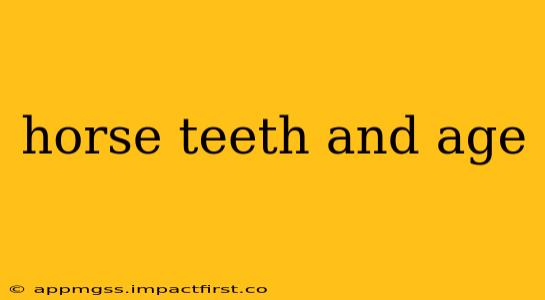Determining a horse's age can be tricky, especially as they mature beyond their youthful years. While official documentation is ideal, examining a horse's teeth offers a valuable, albeit imperfect, method for age estimation. This process, known as "ageing by teeth," relies on understanding the predictable patterns of tooth eruption, wear, and shape changes throughout a horse's life. This guide delves into the intricacies of equine dentition and how it relates to age, addressing common questions horse owners and enthusiasts frequently have.
How Do Horse Teeth Change with Age?
Horses' teeth, unlike human teeth, continue to erupt throughout their lives. This continuous growth is essential because their teeth constantly wear down from chewing tough vegetation. The rate of wear is influenced by several factors, including the horse's diet, chewing habits, and overall health. Therefore, while we can estimate age based on dental characteristics, it's not an exact science.
We'll examine key indicators:
-
Incisors: These are the front teeth, crucial for age assessment. Their shape, angle, and degree of wear change predictably as the horse ages. Young horses have sharp, pointed incisors, while older horses exhibit more rounded, worn-down incisors. The cups (depressions) on the surface of the incisors also gradually disappear with age.
-
Molars and Premolars: Located at the back of the mouth, these teeth are primarily used for grinding. Their rate of wear can also provide clues about age, though it's generally less precise than incisor examination. Wear patterns on molars and premolars can reflect the horse's diet and overall health.
-
Galvayne's Groove: This is a distinctive vertical groove that develops on the upper corner incisors. Its appearance and progression are useful for aging older horses. It typically begins to appear around 10 years of age, reaching the middle of the tooth around 15 years and the bottom around 20. However, even this indicator isn't foolproof.
What Are the Different Stages of Tooth Development in Horses?
The development of horse teeth follows a somewhat predictable timeline, providing valuable information about a horse's age, particularly in younger horses. Veterinarians use this knowledge to identify age ranges in foals and young horses. Here's a simplified overview:
-
Foals (0-1 year): Central incisors erupt first, followed by intermediate and corner incisors. The teeth are sharp and pointed with prominent cups.
-
Yearlings (1-2 years): Incisor cups begin to wear, and the angles of the teeth change.
-
Two-Year-Olds (2-3 years): Further wear on incisors; cups are less prominent.
-
Older Horses (Beyond 3 years): The focus shifts to the shape and angle of the incisors, wear patterns, and the presence/depth of Galvayne's Groove.
How Accurate is Age Determination Through Teeth?
While examining a horse's teeth is a helpful tool, it's essential to understand its limitations. It's an estimation, not a precise measurement. Factors like diet (rough versus soft feed), individual variations in tooth wear, and potential dental issues can affect the accuracy of the assessment. A veterinarian experienced in equine dentistry can offer the most reliable estimate.
Can I Determine a Horse's Age by its Teeth Alone?
No, relying solely on teeth for age determination isn't advisable. It's best used as a supplementary method alongside other available information, such as veterinary records, registration papers, and the horse's overall physical condition. Remember, experienced vets use many factors in their assessment.
What Role Do a Veterinarian and Dental Records Play in Age Determination?
A veterinarian experienced in equine dentistry possesses the expertise to thoroughly examine a horse's teeth, considering various factors beyond simple wear. They can detect irregularities, identify potential dental problems that may influence tooth wear, and provide a more accurate age range estimate compared to a layman's assessment. Ideally, a horse's dental records can provide a timeline of past dental work, assisting with the age estimation process.
What Other Factors Influence a Horse's Tooth Wear?
Several factors influence the rate at which a horse's teeth wear down:
-
Diet: A diet consisting of predominantly hard feed will lead to faster wear compared to a diet of softer feed.
-
Chewing Habits: Horses with abnormal chewing habits might exhibit uneven wear.
-
Genetics: There is individual variation in the rate of tooth wear, influenced by genetics.
-
Dental Health: Dental problems, such as periodontal disease, can affect wear patterns.
In conclusion, while assessing a horse's age using its teeth provides valuable insights, it shouldn't be considered a definitive method. The information provided here is for educational purposes and should not replace professional veterinary advice. Always consult with a qualified equine veterinarian for accurate age determination and comprehensive dental care for your horse.
